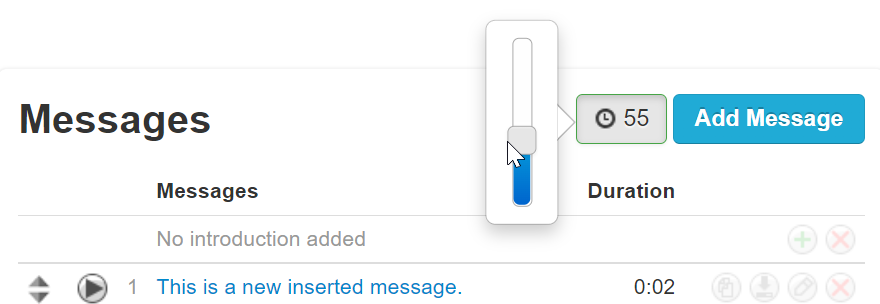Music On Hold - Updated for v43
This article provides a detailed overview of the new Music on Hold (MoH) page available in the Portal, and the new features available for further customizing how the music and messages are played.
Table of Contents
New Music on Hold Features
One of the improvements implemented into the MoH section is the ability to customize the flow of your Music on Hold. Messages can be added that act as announcements. These messages play in between the songs being played as the on-hold music. The music being played can also be ordered or randomized depending on your preference.
For example, while a customer is on hold, the music can now be briefly interrupted with a message. One kind of message commonly used is called a “comfort message”, which can sound like this, "Your call is important to us. Please wait on the line and an agent will be with you shortly."
Quick Tip: The message section can also be used for advertising, updating wait time, and more. These messages are configurable (time between messages, copying messages, etc.) through the Music on Hold section of the portal.
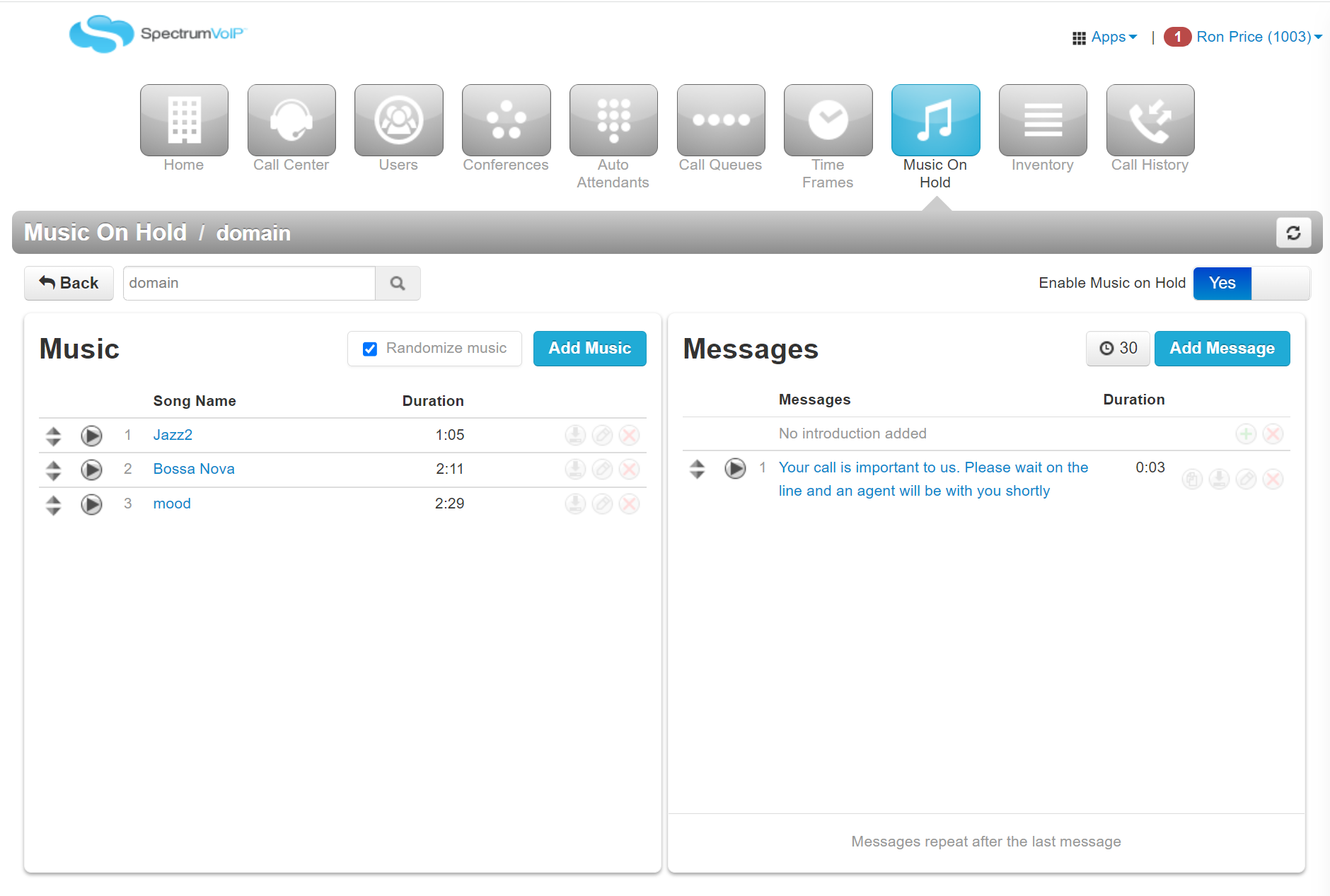
View the Different Music on Hold Pages
There are five different versions of the Music on Hold page:
- Music on Hold Inventory table
- "Domain User" MoH page
- Call Queue MoH page
- Site MoH page
- User MoH page
Scope: Office Managers are able to adjust the Music on Hold (MoH) on the Domain Level. Office Managers can also adjust the MoH for all users, sites and call queues.
Site Managers can adjust the MoH for users and call queues that are a part of their Site.
Basic Users are only able to adjust their own MoH.
There are important differences between these UI layouts as discussed in this section.
The Music on Hold Inventory Table
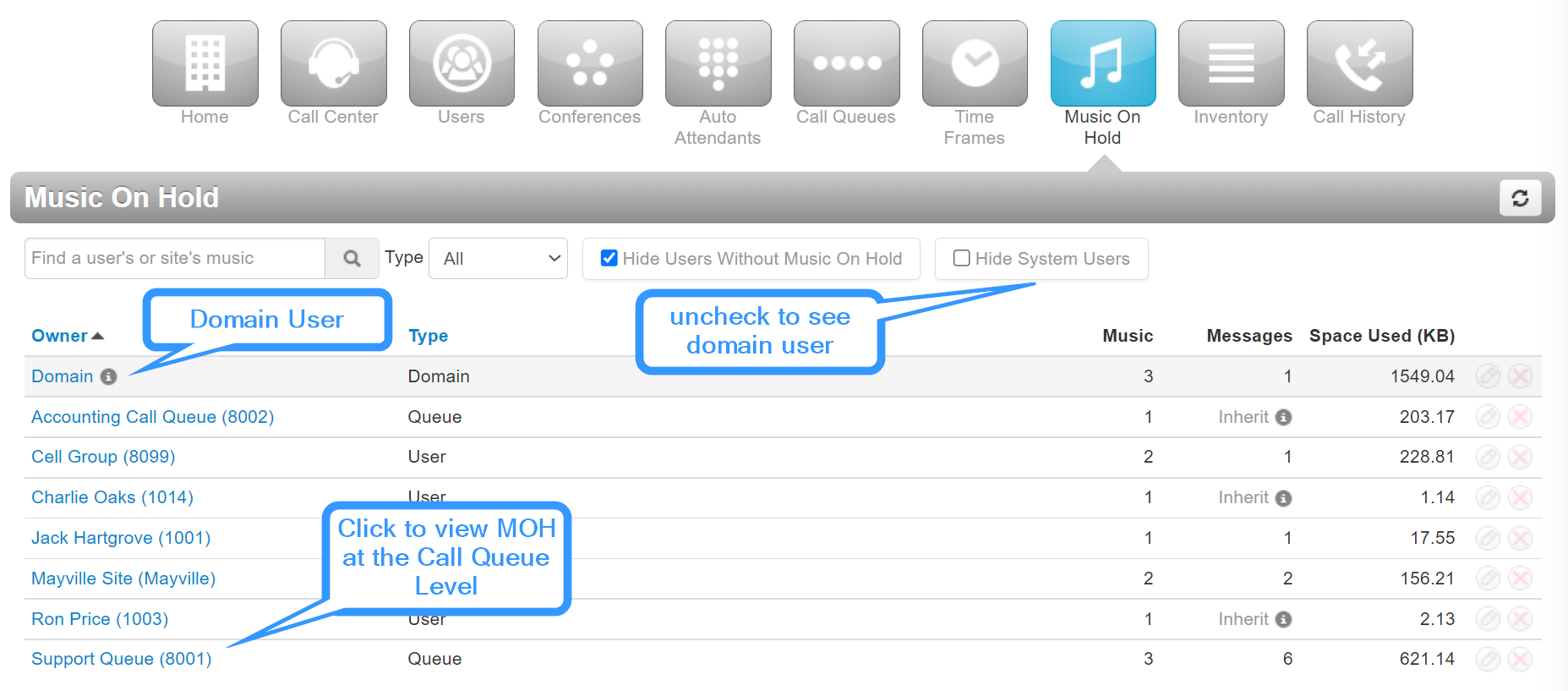
The Music on Hold Inventory Table displays your organization's users that have specific MoH set. Depending on your scope, this page may only show a limited number of users. The Domain User is also present in this list for Office Managers.
Note: By default, this table lists all users and call queues with music on hold (MoH). This page will also hide system users, including the domain user, by default.
✔ To see all users that do not have specific MoH set, uncheck Hide Users Without Music On Hold. To see the domain user, uncheck Hide System Users.
Inherit is a term that you may see. This means that a particular user or call queue is using music or messages that is inherited from a site or a domain user.
"Domain User" MoH Page
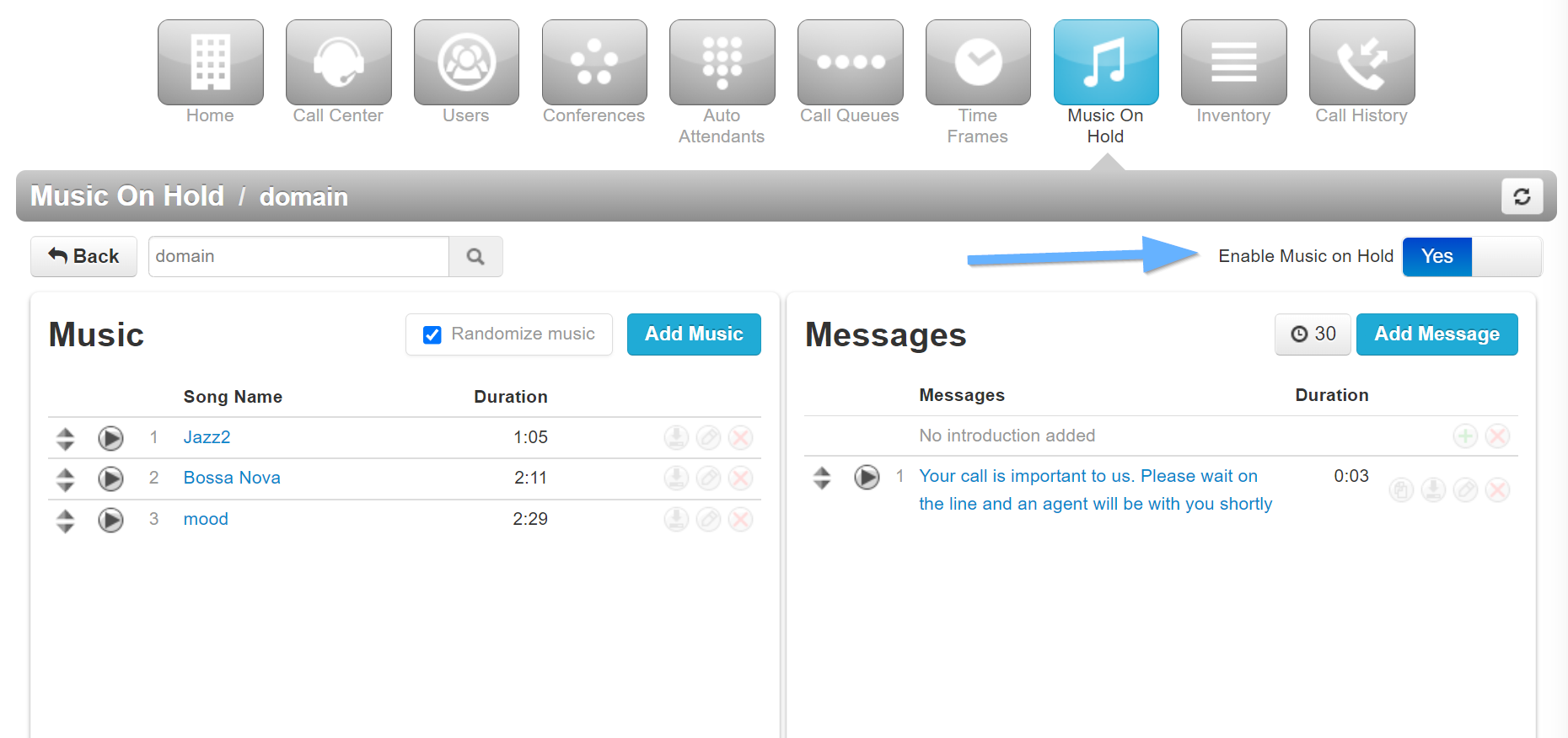
When a new domain is created, the system creates a new user named Domain User. This user houses all default greeting files and images for the domain. There is also an Enable Music on Hold toggle that can turn on or off the MoH for your whole organization.
Quick Tip: When there have not been any changes made to your domain's MoH, the Domain User's MoH page may look empty: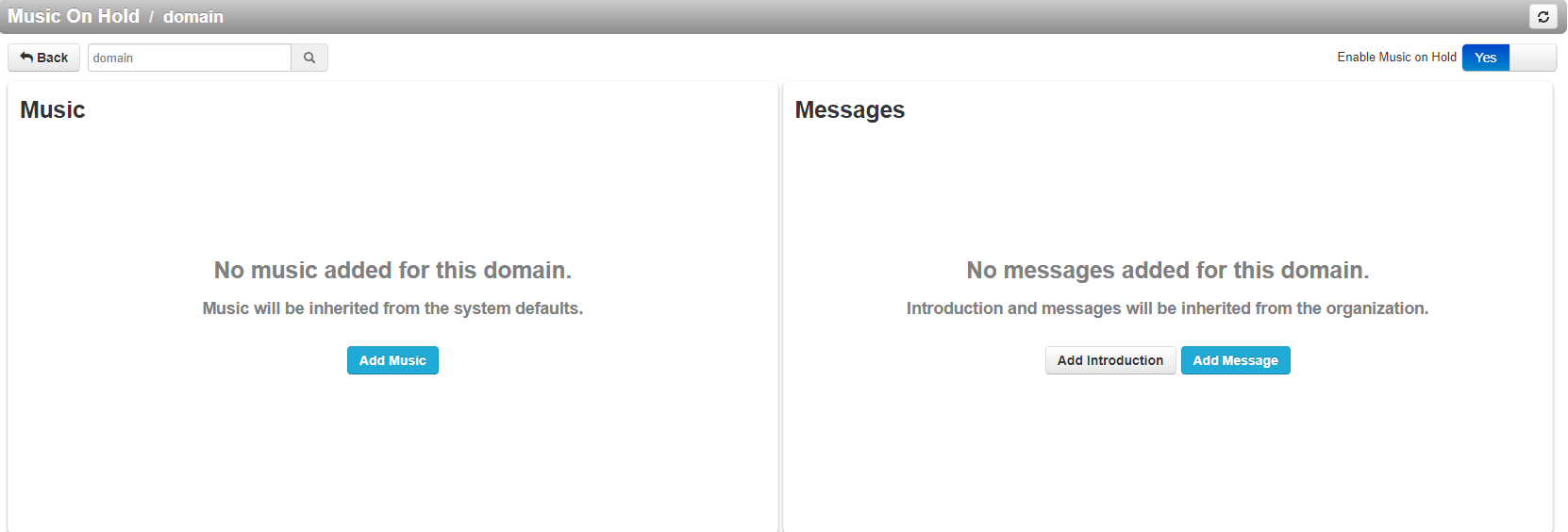
Whenever a domain has not had music on hold added, the domain will use our Spectrum Jazz music by default. To have the genre of music played changed, feel free to contact our technical support team. The music can be changed to either Country, Christian, Soft Rock, or Hip Hop.
Call Queue MoH Page
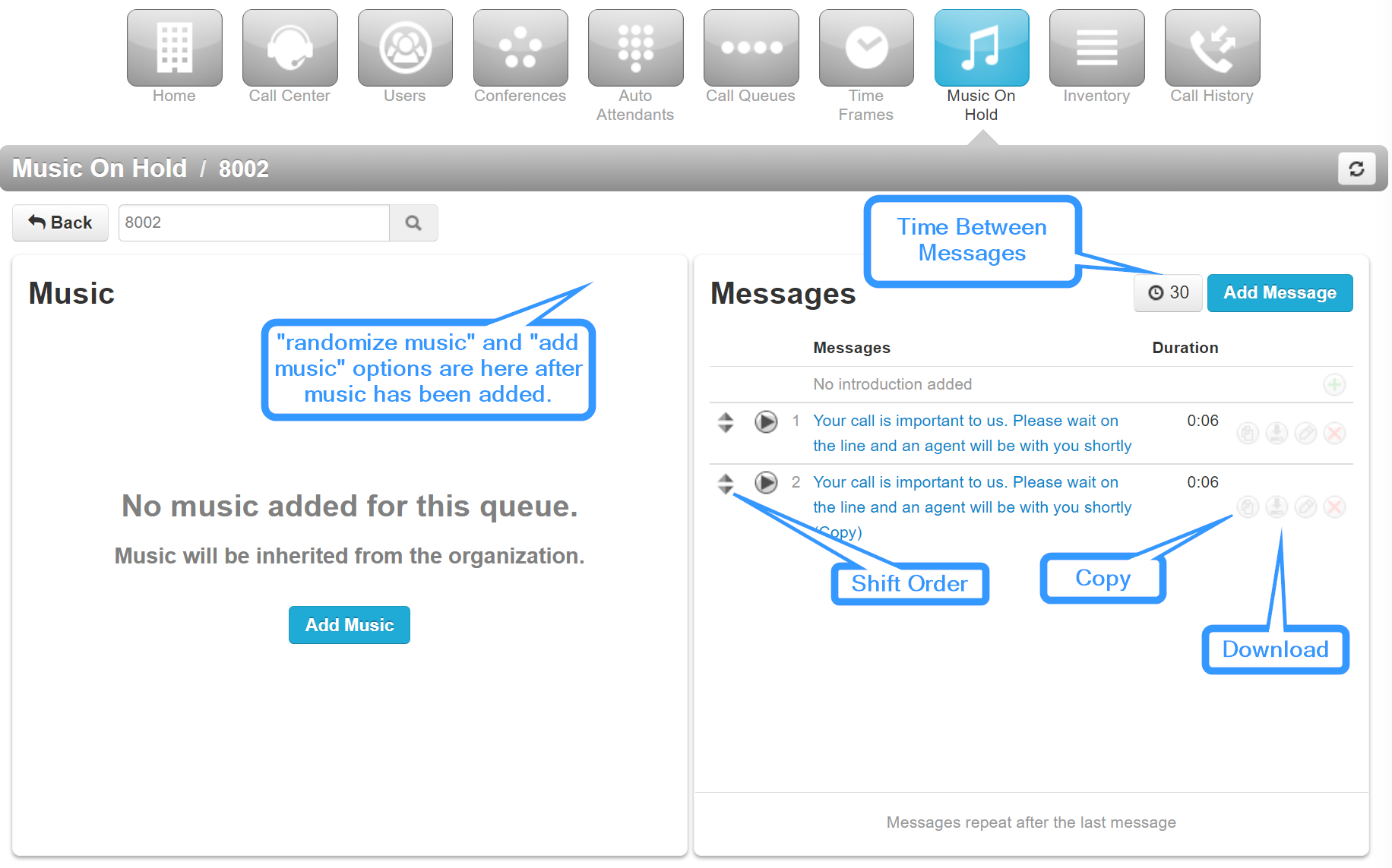
This is the MoH page inside of a call queue. This music on hold page is accessible by either…
- Clicking the name or Edit icon
 of a call queue in the MoH Inventory table.
of a call queue in the MoH Inventory table. 
- Clicking the Edit MOH icon
 for a particular call queue on the Call Queues page.
for a particular call queue on the Call Queues page.
Site MoH Page
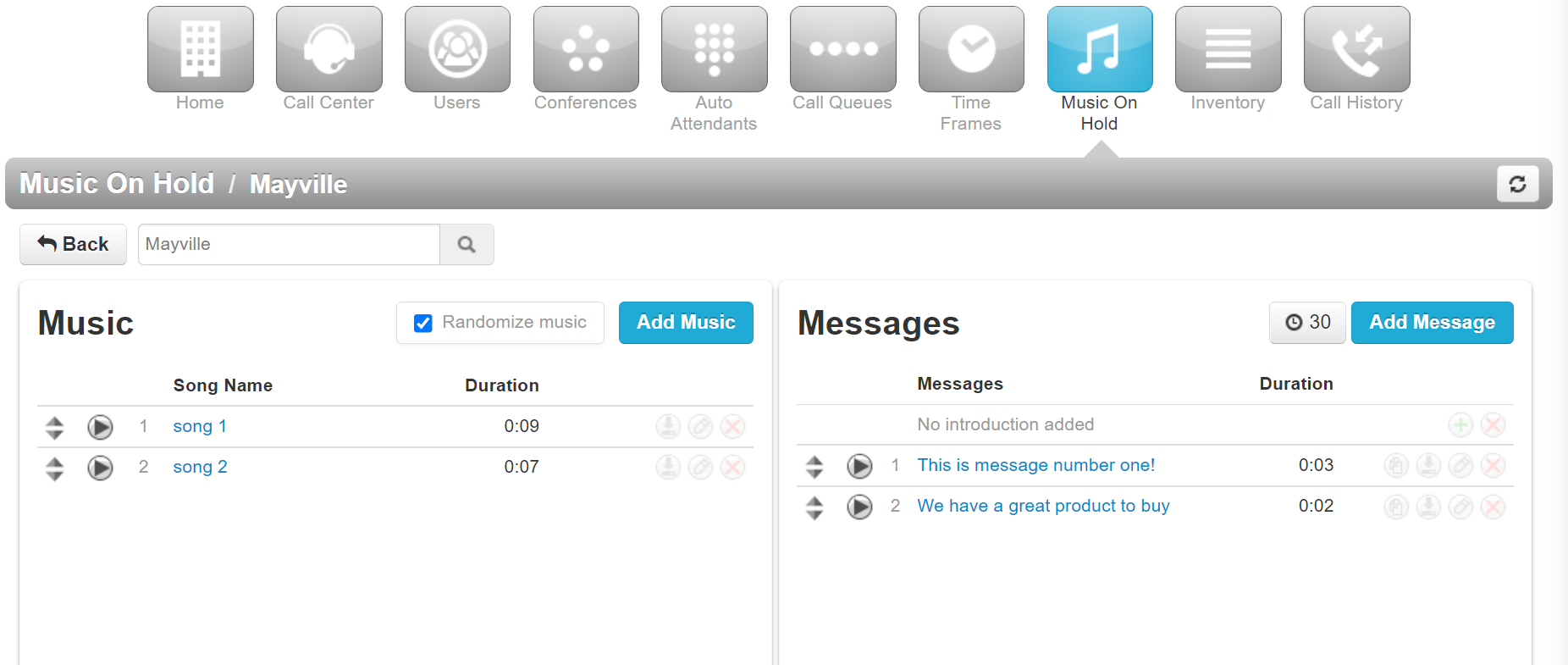
This is the MoH page for a Site. It is accessible by navigating to the Sites tab of the Users page and clicking the Edit MOH icon  .
.
User MoH Page

Basic Users and Call Center Agents can access their own MoH pages to customize their own music on hold and messages. These user scopes do not have access to the MoH inventory table or the Domain User.
Office Managers and above can access their own User MoH page by clicking their name and selecting My Account. 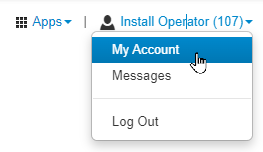
From there, the Music on Hold page can be visited.
Managing Music and Messages
Music can be added and copied from all Music on Hold pages. There are other options available for configuring your music and messages, such as randomizing, adding time between messages, and more.
Add Music
To add in new music…
- Click the Add Music button.

✔ Doing so will pull up the Add Music modal.

- In the Song Name box, type in a name to identify the song with.
- Take a moment to confirm that the music file you would like to add is in a proper format for the phone system.
WARNING: The audio file should be a 16-bit WAV (8Khz, Mono, 16-Bit PCM) file.
Convert an Audio File Using G711.org
To convert the audio file, you can use a free site named g711.org. To do so…
1. Visit g711.org.
2. In the Source File section, click the Browse button.

3. Select the audio file to be converted.

4. In the Output Format section, ensure that the Standard Definition option is selected.
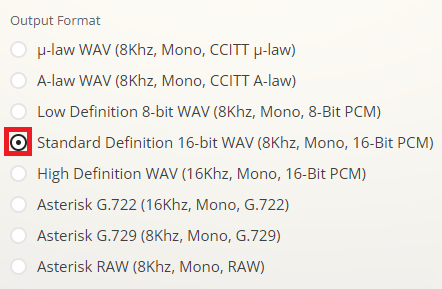
5.Click the Submit button.

✔ Doing so will pull up a new page with a link.
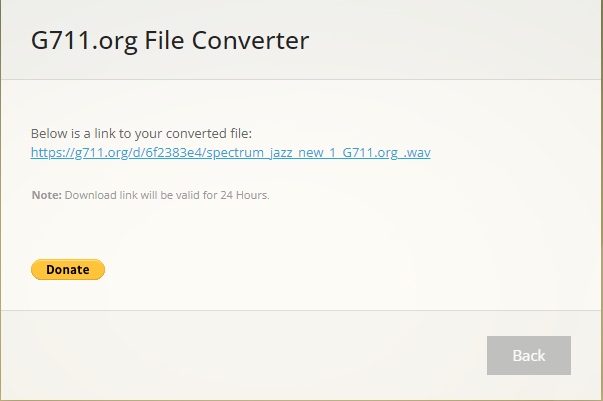
6. Right-click the link and select Save link as.

7. In the File name box, type a name for the converted audio file and then click the Save button.

DANGER: Not converting the music file can cause catastrophic issues for your phone system.
- Click the Browse button.

- Select the converted audio file.
✔ Now the file name and its file path should appear in the box.

- Click the Upload button.

✔ The new song will appear at the bottom of the list of songs in the Music section

Add a Message
To add in a message for callers to listen to while they are on-hold…
- Click the Add Message button.

✔ Doing so will pull up the Add Message modal.
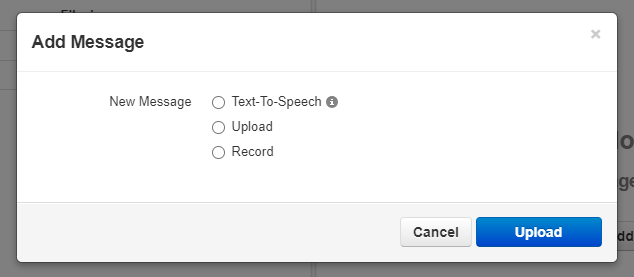
- Use either of these options to add in a Message:
-
Text-to-Speech: Use the text-to-speech option to type in a message and select an automated voice that will read out what is typed. Once the message has been typed out, click the Save button.
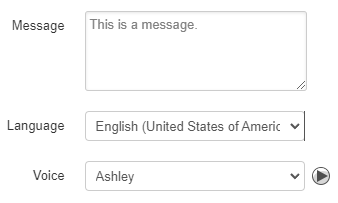
-
Upload: Using the upload option, you can upload a converted audio file and give the message a name. Once the file has been selected on your PC, click the Upload button.

WARNING: The audio file should be a 16-bit WAV (8Khz, Mono, 16-Bit PCM) file.
Convert an Audio File Using G711.org
To convert the audio file, you can use a free site named g711.org. To do so…
1. Visit g711.org.
2. In the Source File section, click the Browse button.

3. Select the audio file to be converted.

4. In the Output Format section, ensure that the Standard Definition option is selected.

5.Click the Submit button.

✔ Doing so will pull up a new page with a link.

6. Right-click the link and select Save link as.

7. In the File name box, type a name for the converted audio file and then click the Save button.

DANGER: Not converting the music file can cause catastrophic issues for your phone system.
-
Record: The record option allows you to type in the phone number or extension number for the phone system to send a call. Click the Call button to send a call to the number. When the call is answered, it will record whatever is said to it.

✔ You should now see the new Message added into the Messages section.

-
Text-to-Speech: Use the text-to-speech option to type in a message and select an automated voice that will read out what is typed. Once the message has been typed out, click the Save button.
Add an Introduction Message
Similar to a regular message, an Introduction Message can be added in. The introduction message is played before any of the music or messages play. This kind of message is useful for notices or warnings, such as that their call may be recorded.
To add in an Introduction Message…
- Click the Add Intro Message icon
 .
. Quick Tip: If there have not been any messages added, you can click the Add Introduction button on the notice that shows in the Messages section.

- Use either of these options to add in an Introduction Message:
-
Text-to-Speech: Use the text-to-speech option to type in a message and select an automated voice that will read out what is typed. Once the message has been typed out, click the Save button.

-
Upload: Using the upload option, you can upload a converted audio file and give the intro message a name. Once the file has been selected on your PC, click the Upload button.

-
Record: The record option allows you to type in the phone number or extension number for the phone system to send a call. Click the Call button to send a call to the number. When the call is answered, it will record whatever is said to it.

✔ You should now see the new Introduction Message added into the Messages section.

-
Text-to-Speech: Use the text-to-speech option to type in a message and select an automated voice that will read out what is typed. Once the message has been typed out, click the Save button.
Rename a Song or Message
To rename a song or message, click the Edit Name icon  next to it and type in the new name for the song/message.
next to it and type in the new name for the song/message.

Delete a Song or Message
To delete a song or message, click the Delete icon  next to it.
next to it.

Re-Order Music or Messages
Once messages and music have been added in, the lists of music and messages can be re-ordered to prioritize when those songs/messages should play.

✔ Once the music or messages have been re-ordered, click the Save button that appears in the warning banner.
Copy Existing Music or Messages
Copy an existing message or song by clicking on the Copy icon  .
.
✔ Clicking Copy will add the same message/song to the bottom of the list with "Copy" appended to the name.
Copy and Modify Music from the Organization
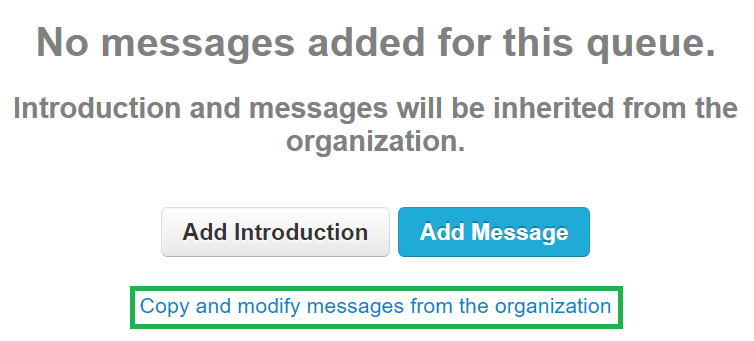
To make selecting a user's MOH (Music on Hold) easier, the Copy and Modify Music from the Organization feature allows you to take the music/messages from the domain level and copy them onto a user. From there, the user's music/messages inherited from the domain can be edited and deleted to fit the user's needs.
To do this…
- Search the user or call queue that will need this adjustment.

- Click the Copy and Modify Music from the Organization hyperlink.

- Once this hyperlink is clicked, the selected section will update to list out the audio used by the domain.

- If needed, edit the name of an audio file using the Edit
 icon or delete a message using the Delete
icon or delete a message using the Delete  icon.
icon.
Randomize Music
The Randomize Music feature randomly orders the music when a user is calling in and is put on hold.
It can be enabled by selecting the Randomize music checkbox.
Time Between Messages
The Time Between Messages feature sets the time between the end of one message and the start of the next one. Within each of these breaks, the music will resume.
This can be adjusted with a slider in increments of 5 seconds. The default value for the time between messages is 30 seconds, but this value can range from 15 to 120 seconds.
Inheritance
Music and messages are inherited separately. One can be inherited without the other and vice versa. The more granular the level; the higher the priority. Continue reading for important clauses and things to remember.
Randomize Music and Time Between Messages
Settings are inherited along with their corresponding table. The setting to "Randomize" is inherited along with music. The setting for "time between messages" is inherited along with messages.
No Music or Messages
A user is able to set their own music and messages. If the user does not set either of these, they will automatically inherit from first their site and then if their site is empty as well, then finally from their domain. In this specific situation, the Portal will not display what a user has inherited. Inheritance is happening "behind the scenes". Their tables will appear blank.
In order for the user to see and modify what they have inherited, then they must select "copy and modify [...] from the organization". However, at this point, after clicking to copy, now their music/messages are static and no longer dynamically inherited. To revert back to dynamically having the latest organization defaults, the user would have to delete all of their rows back to a blank UI.
Copy & Modify from Site/Organization
The option to "copy and modify" in each of the tables is only present when there is no visible music and there are no visible messages (the user has set neither of them up). After a user has added their own music or their own messages, the option to copy is gone. They can delete all of their own added rows in order to view the copy option again.
Introduction Message
The introductory greeting is an audio prompt that can be used as a notice or warning for callers. This is useful for companies that may need to note that their “calls may be recorded for quality and assurance purposes.”
When it is inherited, this greeting exists in the first row of the Messages table by default. If a user has added custom music to their account, then they will no longer be able to inherit their site or domain "introduction" greeting.

